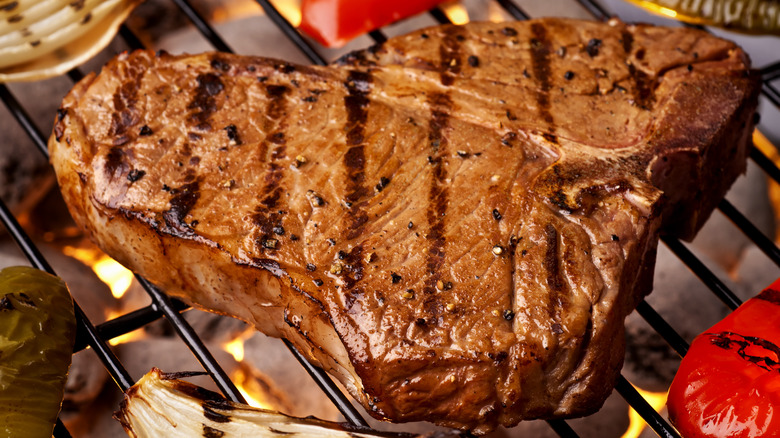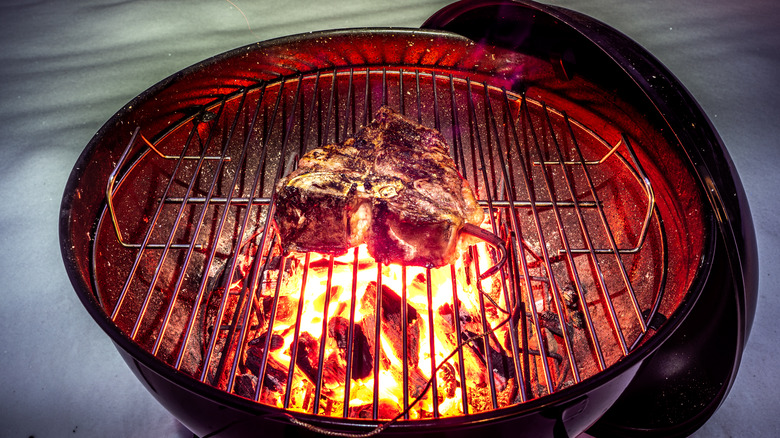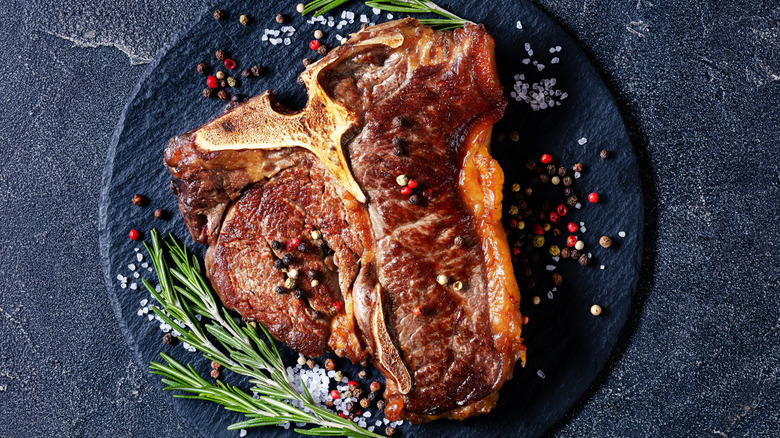The Best Steak Cuts To Reverse Sear, According To An Expert
The reverse sear is a rather recent technique, one whose invention dates back only to 2007. This way of cooking steaks has quickly become popular, however, despite the fact that it's slightly more involved than traditional cooking methods, in that it requires an extra step. Before skillet searing your steak over high heat for the perfect crust, you must first cook it over low heat in the oven, typically for about 35 minutes at 250 degrees Fahrenheit — although timing can vary depending upon the desired doneness level. Grills can also be used for these steps, too, but it's slightly different.
The reverse sear method is noted for its ability to cook a steak evenly, and with precise control over doneness. It bears noting, though, that reverse searing may not be appropriate for all steak cuts. According to expert Dustin Green, Head Grill Master and Director of Weber Grill Academy, Americas: "The biggest thing with a reverse-seared steak is thickness. Thicker steaks do better with reverse searing. The cut of steak is a personal preference."
Thinner steak cuts cook too fast for the reverse sear to be a preferred option — but for thicker cuts, it's a great method, and not just because your steaks have a beautiful even color and are cooked to perfection. Reverse searing also gives thicker-cut steaks more tenderness and flavor.
Go thick or go home
According to Green, any thick cut of beef is appropriate for reverse searing. That eliminates thinner cuts like flank or skirt steaks, whose thickness levels are typically one inch or less. Tri-tip, which is also in the range of one inch of thickness, is also too thin for reverse searing. So-called thick cuts, by contrast, are those between an inch and a half and three inches in thickness, so popular favorites like ribeye, T-Bone, Porterhouse, New York strip, tomahawk, and filet mignon cuts.
As for which of the above cuts are best, Green notes that it's a matter of taste. So long as the cut is over one and a half inches in thickness, it won't cook too fast for an even pink center. Oven cooking, too, can be replaced with careful grilling. Green's company, Weber Grill, recommends grilling thick steak cuts away from charcoal until their internal temperature reaches 120 before searing directly over the fiery coals to achieve a perfect medium rare doneness level of 130 degrees Fahrenheit.
Obviously, a two-zone approach is necessary for this technique, with all the charcoal grouped on one side of the grill. But the result is the same: a perfectly cooked steak with an incredibly flavorful, caramelized crust.
Why reverse searing is a good idea
"The benefit of reverse searing," Green told Food Republic, "is a slower, longer cook that allows the meat to break down and become tender. It also allows the steak to have more of an evenness of color after the reverse searing occurs. Lastly is flavor. The caramelization created on a reverse sear is added flavor from the natural sugars in the meat browning and creating added beauty and taste."
Traditional pan-frying can create that wonderful, flavorful crust we all enjoy on a good steak, but that crust can form fast. The inside of the meat won't have time to develop the same deep flavor and tenderness we get from the slow cook of a reverse sear.
The oven time also adds to the precision of control, allowing for perfect doneness levels — rare, for example, is indicated when the steak's internal temperature gets to 115 degrees Fahrenheit in the oven; 120 indicates medium rare — with the temperature then brought up another 10 degrees or so via searing at high heat. This precise temperature control helps to prevent overcooking that sometimes occurs with other methods — and the dreaded gray band we all want to minimize.



